Winter
Wildlife in Tuolumne Meadows
Yosemite National Park
WINTER
2004/2005
Tracey
Wiese and Bruce Carter
Tuolumne Winter Rangers, Yosemite National Park
BIRDS
This winter was unusual in that the “common birds” did not seem as common and instead we had sightings of birds that are not normally seen in this area during the winter months. Obviously our bird sightings depend on where we happen to be on a given day and what we happen to see, but certain patterns seemed different this year than during our previous winters here.
WINTER RESIDENTS
MOUNTAIN CHICKADEE ( Poecile gambeli ) The number of Chickadees seemed to be less this year than in our previous two winters. While present throughout the winter the trees often seemed to be quiet, lacking the chatter of busy Chickadees at work. The lodgepole pine cone crop seemed to be less this year which may explain the smaller winter population of Chickadees.
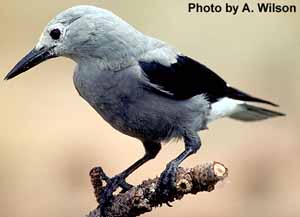 |
| Clark's
Nutcracker: Bird most likely to wash out of American Idol. Heart, but
no song. Photo: USGS |
CLARK’S NUTCRACKER ( Nucifraga Columbiana) While never present in large numbers this winter we did see Clark’s Nutcrackers every month of the winter.
AMERICAN ROBIN (Turdus migratorius) While we have had Robin sightings in other winters they seemed to be especially noticeable this winter. We saw Robins literally every month of the winter and spring. By mid-March they seemed to be present in larger flocks.
COMMON RAVEN (Corvus corax) Ravens seemed more common this year than the last few. We saw them every month of the winter this year.
NORTHERN FLICKER (Colaptes auratus) Flickers either arrived earlier this spring or else were around through the winter. We first noticed one on March 9 and then sporadically thereafter until mid-April when we either saw or heard them very regularly.
GRAY-CROWNED ROSY FINCH (Leucosticte arctoa) On November 11 we watched a flock of Rosy Finches on the clear ice of Evelyn Lake catching bugs. On March 18 a visiting skier spotted a flock on Mammoth Peak. And on April 11 we saw a number of them on Mt. Lyell as they flew in and perched on the rocks and watched us cutting steps in the ice. We also saw and heard these finches the previous evening near our camp at the foot of the Lyell Glacier. Despite the strong winds and blowing snow these alpine birds seemed right at home while we were quite uncomfortable.
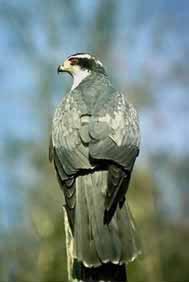 |
| Northern Goshawk (Accipter
gentiles) Photo: Kidzone |
NORTHERN GOSHAWK (Accipiter gentiles) We had a couple of Goshawk sightings this winter/spring, one was in Lyell Canyon as it soared along the edge of the trees on April 10. Later, on that same ski trip when we were skiing back to Tuolumne via Sunrise Lakes we spotted one flying above the trees there.
WHITE BREASTED NUTHATCH ( Sitta carolinensis) Nuthatches did not seem as common this year as previous years. We had only one confirmed sighting of a White-breasted nuthatch on January 13.
DARK-EYED JUNCO (Junco hyemalis) Juncos arrived in early April this year, we did not spot any through the winter. By mid-April they were quite common in the Tuolumne area and we often saw them around our cabin.
CANADA GOOSE (Branta Canadensis) I would normally include geese in the Spring Arrivals but the sightings we had were not in the spring. On February 4, as we were skiing near Glen Aulin, we suddenly heard the unmistakable honk of a goose and looked up to see a lone goose winging its way north. On our return just north of this same area on February 13 we heard and saw a flock of approximately 50 geese flying northeast. Then, early in the morning on February 24, a flock of about 8 geese was spotted on the snow in Dana Meadows. They were on a slight rise in the middle of the meadow and appeared to have roosted there for the night.
BLUE GROUSE (Dendragapus obscurus) We did not see any sign of Blue Grouse this winter until April 24. We were skiing up the ridge to the south of the Tioga Road in route to Mammoth Peak when we saw the distinctive tracks in the snow.
BALD EAGLE (Haliaeetus leucocephalus) On November 24 we spotted a Bald Eagle flying up the Tuolumne River out in the meadows. It was our only Bald Eagle sighting this season.
STELLAR’S JAY (Cyanocitta stelleri) Stellar's Jays were noticeably absent this winter. In our previous 4 winters here there have always been one or two Jays that spent the winter between the Ski Hut and the Winter Ranger Cabin. This winter we spotted one on February 13 down near Glen Aulin and then not again until April when they began arriving. By late April we were seeing them near Tenaya Lake and near our cabin.
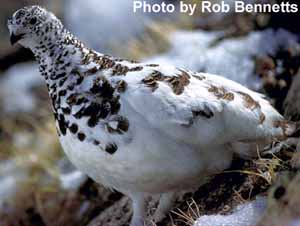 |
| White
Tailed Ptarmigan, molting from winter white. USGS Photo : Bob Bennetts |
WHITE-TAILED PTARMIGAN (Lagopus leucurus) We saw their tracks a few times this winter, though we never did spot a Ptarmigan. Their tracks were seen at the big rock in the Tuolumne River near Parsons Lodge, and also in Squirrel Basin on the eastern side of Johnson Peak. All of the tracks occurred at or near exposed willow.
CASSIN’S FINCH (Carpodacus cassinii) Ten Cassin’s Finches were spotted out by Parson’s Lodge on February 5.
GREAT HORNED OWL (Bubo virginianus) Out in the middle of Tuolumne Meadows on the morning of January 18 we saw the wing tracks of an owl as it dropped down to take a mouse, whose tracks ended at the wing marks. Then on the evening of April 4 right at the Tuolumne River Bridge I saw an owl appear as if from nowhere and fly up the river on its big, quiet wings.
BROWN CREEPER (Certhia americana) We had only one sighting of a Brown Creeper this winter, it was on a tree next to the Tuolumne Ranger Station on March 5.
BLACK-BACKED WOODPECKER (Picoides arcticus) Though we often hear woodpeckers, spotting them and identifying them is another thing. We did see one Black-backed Woodpecker on April 10 up near the head end of Lyell Canyon. I saw a tree with many, many small holes in it and was looking further up the tree at the continuation of holes when I spotted the woodpecker. It was totally silent and it just a coincidence that I happened to look up high enough to see it.
WILLIAM’S SAPSUCKER (Sphyrapicus thyroideus) We first identified a female on April 29 as it hopped about on the trunk of a tree near Little Blue Slide about a half mile up the hill from Ranger Camp.
WHITE-HEADED WOODPECKER (Picoides albolarvatus) We were skiing up the John Muir Trail above Sunrise Creek when we saw a White-headed Woodpecker on a tree.
SPRING ARRIVALS
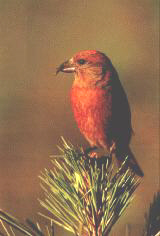 |
| Red Crossbill Photo: Illinois Raptor Center |
RED CROSSBILL (Lozia curvirostra) March 8 and 9 were the first Crossbill sightings though they did not ever seem common.
KILLDEER (Charadrius vociferus) As seems to happen every year, the first Killdeer sighting was at Soda Springs, this year on April 17. There was very little open ground around the cribbing surrounding the springs, and another bare spot that was perhaps 10’by 5’. 5 Killdeer were making use of this bit of bare ground.
CALIFORNIA GULL (Larus californicus) First seen high above Tioga Pass on March 8 and 9, we later spotted them flying high above Mount Gibbs on April 25. Occasionally we would hear them but not be able to spot them.
YELLOW-RUMPED
WARBLER (Dendroica coronata) We spotted the first
Yellow-Rumped Warbler from our deck as it flew from tree to tree
on April
16. After this time we saw them quite regularly.
VIOLET-GREEN SWALLOW (Tachycineta thalassina) On March 18 we spotted the first swallows of the spring as they flew east to west near Pothole Dome. Thereafter we saw them occasionally until it became a regular occurrence to spot them.
RED-WINGED BLACKBIRD (Agelaisus phoeniceus) Another visitor to the Soda Springs area, 2 blackbirds were the first that we saw of the season. Once having arrived here in however small a number they seem to quickly increase and become regular residents.
BREWER’S BLACKBIRD (Euphagus cyanocephalus) These blackbirds showed up in a flock on April 23 as we were doing chores around the cabin. They hung around where we were working poking about in the firewood debris and flitting in and out of the trees.
RED-TAILED HAWK (Buteo jamaicensis) On April 21 while skiing through Tuolumne Meadows a shadow went across the sun and we both looked up to see a light phase Red-Tailed Hawk soaring above us.
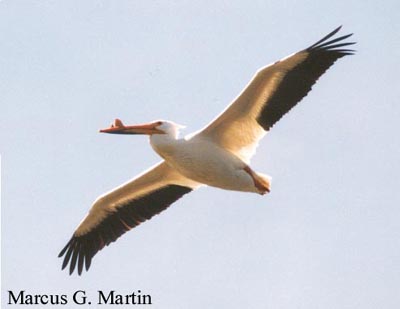 |
| White
Pelican (Pelecanus erythrorhynchos) Photo: The Complete Photographic Guide to Birds of the World |
AMERICAN WHITE PELICAN ( Pelecanus erythrorhynchos) We had ranged out of the Tuolumne area and on April 11 near Mt. Ansel Adams we spotted a flock of pelicans flying high above us. We watched them dip and soar until they disappeared to the east.
MALLARD (Anas platyrhynchos) These seem to usually be the first ducks to arrive on the Tuolumne River. We saw 2 Mallards on April 21 and 22, and then their numbers increased until we were seeing several pairs at a time. They always seem to appear at the same section of the river each year.
COMMON MERGANSER(Mergus merganser) A pair of merganser ducks were first seen on the Tuolumne River by the bridge near Parsons Lodge on May 4.
UNUSUAL SIGHTINGS
GREAT BLUE HERON (Ardea herodias) On January 22 we were skiing through Tuolumne Meadows and noticed a large gray bird flying in the distance. We were still puzzling over what it was when we skied up to the shore of the river where its enormous tracks gave it away. The Heron had walked along the shore in a place where there was a little bit of fast moving water which had not yet frozen over. Mono Basin had been socked in with fog for many days and we speculated that it was just a quick flight up to the sunshine of the Meadows even though the fishing was marginal.
EARED GREBE (Podiceps nigricollis) In late February our neighbors at Tioga Pass Resort had an interesting bird encounter that they shared with us. An Eared Grebe landed near a pile of backpacks in front of the lodge and, without a stretch of water necessary to take wing, it was stranded there. They kept “Trooper” in the bathtub for the night then transported it down the canyon to the folks at the Mono Lake Committee in Lee Vining who released it at Mono Lake.
MCCOWN’S LONGSPUR(Calcarius mccownii) On November 1 this little bird was sitting on the ground near the Dana Fork Bridge near Tuolumne Lodge. It was odd that it didn’t fly off at our approach, and as we got closer we slowed down until we were literally right next to it. It hopped around a bit but didn’t seem inclined to fly and we were able to look at it for some time, studying its features. Finally, we decided to leave and as we scooted by it did fly up into the branches of a nearby tree. Later we perused through all of our bird books and both agreed that it was a McCown’s Longspur, even though it does not normally inhabit this area.
INSECTS
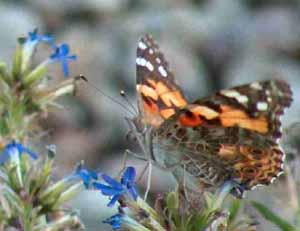 |
Painted-Lady
Butterfly (Vanessa
cardui) |
PAINTED-LADY BUTTERFLIES (Vanessa cardui) We spotted our first Painted-Ladies of the spring on March 9 when we saw just two. We continued to see them off and on throughout the spring as they determinedly made their way west. April 5 was the peak migration day in Tuolumne Meadows with literally thousands of them passing through. With 4 people observing we made an unofficial count of at least 500 butterflies per minute passing through the Meadows in the middle of the day. It was an impressive sight.
SPHINX MOTH (Sphingidae) On the morning of April 17 Bruce saw a Sphinx Moth on the surface of the snow near Parson’s Lodge. It is the only one that we have seen this winter. Other types of moths began showing up in April but we were unable to identify them.
AMPHIBIANS
FROG This is a general description since we did not see or identify the type of frog, however it seemed worth noting. On April 27, late in the day, we were taking snow samples at the Tuolumne Snow Sensor Building. It was 33 degrees and had just begun to snow quite hard. We both heard the unmistakable croak of a frog and looked at each other to see if the other had also heard it. There was a bit of open, running water where the summer trail (old road) comes down the hill from the Wilderness Permit building toward Lembert Dome Picnic area. When Lembert Dome has melting snow this little creek takes over the trail in this area. Otherwise the area was totally covered in at least 5-1/2 feet of snow. The sound of the croaking frog seemed extremely out of place and surprised us both.
WORM This is an out of place, or perhaps out of season, sighting but it was so unusual that we wanted to make note of it. While conducting a Snow Survey, again at the Tuolumne Meadows Snow Sensor building, a snow core was taken and, as always, a bit of soil is brought up with the sample. The soil contained a small, whitish worm, about 1/16 th “diameter (pencil lead size) and about 1” long.
THE TUOLUMNE RIVER
Some general observations about the river: By the first of April we had stopped skiing across the river in Tuolumne Meadows since a few areas were opening up and in places the snow on the river was looking kind of bluish. It was still quite easy to cross both the Dana Fork and the Lyell Fork, above the confluence, until nearly the end of April. By the end of the first week of May the river was open with large “islands” of snow still in it in many places.
Something that
was very noticeable throughout the winter, and also in previous winters,
is the incredible amount of silt that enters the Dana Fork of the Tuolumne
River at Little Blue Slide whenever it gets warm. In a matter of hours
the river can go from being crystal clear to being extremely muddy. On
a warm day the sun hits that south facing road cut and the mud literally
flows off the bank to the snow covered road below. There is a drain and
a culvert to divert the muddy water under the Tioga Road and into the Dana
Fork. It is always a shock to see what should be a clear, mountain river
become so muddy that one cannot see into the water at all. That one road
cut must add an amazing (and I assume, unnatural)
amount of silt to the river.
Further Information
Cornell
Lab of Ornothology All about Birds Descriptions, maps and calls of
individual species
Patuxent
Wildlife Research Center
Enautre.com Excellent
source of wildlife information, maps and photos
CALIFORNIA
Heavy rains produce crop of migrating butterflies Bay Area decorated by painted
ladies on journey north
Glen Martin, SF Chronicle Environment Writer
Our Founder Questions? Go to About Our New Site |
Masthead
Photo from: |